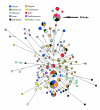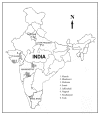Phylogeography and domestication of Indian river buffalo
- PMID: 17915036
- PMCID: PMC2140268
- DOI: 10.1186/1471-2148-7-186
Phylogeography and domestication of Indian river buffalo
Abstract
Background: The water buffalo- Bubalus bubalis holds tremendous potential in livestock sector in many Asian countries, particularly India. The origin, domestication and genetic structure of the Indian river buffalo are poorly understood. Therefore, to understand the relationship among the maternal lineages of Indian river buffalo breeds and their domestication process, we analysed mitochondrial D-loop region of 217 animals representing eight breeds from eight different locations in India along with published sequences of Mediterranean buffalo.
Results: The maximum parsimony tree showed one major clade with six internal branches. Reduced median network revealed expansion from more than one set of haplotypes indicating complex domestication events for this species. In addition, we found several singleton haplotypes. Using rho statistics, we obtained a time estimate of 6300 years BP for the expansion of one set of hapltoypes of the Indian domestic buffalo. A few breed specific branches in the network indicated an ancient time depth of differentiation of some of the maternal lineages of river buffalo breeds. The multidimensional display of breed pairwise FST values showed significant breed differentiation.
Conclusion: Present day river buffalo is the result of complex domestication processes involving more than one maternal lineage and a significant maternal gene flow from the wild populations after the initial domestication events. Our data are consistent with the available archaeological information in supporting the proposition that the river buffalo was likely to be domesticated in the Western region of the Indian subcontinent, specifically the present day breeding tracts of the Mehsana, Surati and Pandharpuri breeds.
Figures





References
-
- Cockrill WR. The water buffalo: a review. Brit Vet J. 1981;137:8–16. - PubMed
-
- George M, Balaine DS, Vij PK, Kumar S. Conservation and management of buffalo genetic resources of India. In: Nagarcenkar R, editor. Buffalo Production and Health. ICAR, New Delhi; 1988. pp. 31–37.
-
- Beja-Pereira A, Caramelli D, Lalueza-Fox C, Vernesi C, Ferrand N, Casoli A, Goyache F, Royo LJ, Conti S, Lari M, Martini A, Ouragh L, Magid A, Atash A, Zsolnai A, Boscato P, Triantaphylidis C, Ploumi K, Sineo L, Mallegni F, Taberlet P, Erhardt G, Sampietro L, Bertranpetit J, Barbujani G, Luikart G, Bertorelle G. The origin of European cattle: evidence from modern and ancient DNA. Proc Natl Acad Sci USA. 2006;103:8113–8118. doi: 10.1073/pnas.0509210103. - DOI - PMC - PubMed
Publication types
MeSH terms
Substances
LinkOut - more resources
Full Text Sources
Medical
Miscellaneous

